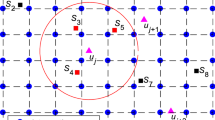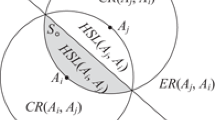Abstract
In recent years, the demand for indoor location-based services has gradually received greater attention. The presence of multipath interference has a tendency to interfere with traditional algorithms calculated based on received signal strength (RSS). The application of virtual tags can greatly reduce deployment costs and enable greater environmental adaptability. However, an excess of ineffectively filtered virtual tags will only lead to greater error in calculation. Therefore, virtual tags are combined with a two-step clustering method to replace the concept of signal hotpoint intersections due to the mutual interdependence of data in space and the influence of neighboring objects. This study improved a two-step location algorithm that combines the advantages of virtual tags and two-step clustering analysis, called clustering-based localization algorithm, offering significant improvement over most traditional localization algorithms. RSS are no longer used as a basis for clustering, and are replaced by the combination of signal and coordination pattern. Two steps of cluster analysis are performed during the filtering process. The first step utilizes the tags’ signals to perform clustering. The second step incorporates tags’ coordinate for filtering. As the clustering-based localization process considers the interactive relationship between coordinate data, it achieves superior results compared to those produced via methods that only use signal strength to select neighboring solutions. This study then constructs a wireless sensor network and assesses the effectiveness of the algorithm.












Similar content being viewed by others
References
Ahmad, U., Gavrilov, A. V., Lee, S., & Lee, Y.-K. (2008). A modular classification model for received signal strength based location systems. Neurocomputing, 71(13–15), 2657–2669.
Bahl, P., & Padmanabhan, V. N. (2000). RADAR: an in-building RF-based user location and tracking system. Paper presented at the nineteenth annual joint conference of the IEEE computer and communications societies.
Bekkali, A., Sanson, H., & Matsumoto, M. (2007). RFID indoor positioning based on probabilistic RFID map and kalman filtering. In Third IEEE international conference on wireless and mobile computing, networking and communications, WiMob 2007, 8–10 October 2007 (p. 21).
Chong, W., Hongyi, W., & Nian-Feng, T. (2007). RFID-based 3-D positioning schemes. Paper presented at the 26th IEEE international conference on computer communications, INFOCOM, 6–12 May 2007.
Enge, P., & Misra, P. (1999). Special issue on global positioning system. Proc. IEEE 87(1), 3–15.
Ester, M., & Kriegel, H.-P. (1999). Knowledge discovery in spatial databases. Paper presented at the proceedings of the 23rd annual German conference on artificial intelligence: advances in artificial intelligence.
Hand, D., Mannila, K., & Smyth, P. (2001). Principles of data mining. Cambridge: MIT Press.
Hightower, J., & Borriello, G. (2001). A survey and taxonomy of location systems for ubiquitous computing.
Hightower, J., Vakili, C., Borriello, C., & Want, R. (2000). Design and calibration of the SpotON AD-Hoc location sensing system. DARPA contract N66001-99-2-8924.
Hightower, J., Want, R., & Borriello, G. (2000). SpotON: an indoor 3D location sensing technology based on RF signal strength.
Hinckley, K., & Sinclair, M. (1999). Touch-sensing input devices. Paper presented at the proceedings of the SIGCHI conference on human factors in computing systems: the CHI is the limit.
Jun, M., Xuansong, L., Xianping, T., & Jian, L. (2008). Cluster filtered KNN: a WLAN-based indoor positioning scheme. Paper presented at international symposium on the world of wireless, mobile and multimedia networks, WoWMoM, 23–26 June 2008.
Ma, L., Xu, Y., & Wu, D. (2010). A novel two-step WLAN indoor positioning method. Journal of Computational Information Systems, 7, 4627–4636.
MacQueen, B. J. (1965). Some methods for classification and analysis of multivariate observations. Paper presented at the proceedings of the fifth Berkeley symposium on mathematical statistics and probability, University of California Press.
Ngah, S., Zhu, H., Chen, K.-T., Tanabe, Y., & Bana, T. (2009). Artificial neural network based model for local position systems. Int. J. Comput. Sci. Netw. Secur., 9(7), 97–106.
Ni, L. M., Liu, Y., Lau, Y. C., & Patil, A. P. (2003). LANDMARC: indoor location sensing using active RFID. Paper presented at the proceedings of the first IEEE international conference on pervasive computing and communications.
Pahlavan, K., Xinrong, L., & Makela, J. P. (2002). Indoor geolocation science and technology. IEEE Communications Magazine, 40(2), 112–118.
Rappaport, T. S. (1996). Wireless communications: princelples and practice. New York: Prentice Hall.
Sanhae, K., Jungwoo, L., Myungsik, Y., & Yoan, S. (2009). An improved TDoA-based tracking algorithm in mobile-WiMAX systems. Paper presented at the IEEE 20th international symposium on personal, indoor and mobile radio communications, 13–16 September 2009.
Savvides, A., Han, C.-C., & Strivastava, M. B. (2001). Dynamic fine-grained localization in ad-hoc networks of sensors. Paper presented at the proceedings of the 7th annual international conference on mobile computing and networking.
Sharma, S. (1996). Applied multivariate techniques. New York: Wiley. Har/Dis ed.
Wang, C., Wu, H., & Tzeng, N. (2007). RFID-based 3-D positioning schemes. Paper presented at the IEEE INFOCOM.
Want, R., Hopper, A., Falcão, V., & Gibbons, J. (1992). The active badge location system. ACM Transactions on Information Systems (TOIS), 10, 91–102.
Ward, J. H. (1963). Hierarchical grouping to optimize an objective function. Journal of the American Statistical Association, 58(301), 236–244.
Yang, C.-C. (2006). A RFID-based location sensing mechanism. Hsinchu: National Chiao Tung University.
Zhao, Y., Liu, Y., & Ni, L. M. (2006). VIRE: active RFID-based localization using virtual reference elimination. Paper presented at international conference on the parallel processing.
Author information
Authors and Affiliations
Corresponding author
Rights and permissions
About this article
Cite this article
Cheng, CY. Indoor localization algorithm using clustering on signal and coordination pattern. Ann Oper Res 216, 83–99 (2014). https://doi.org/10.1007/s10479-012-1219-x
Published:
Issue Date:
DOI: https://doi.org/10.1007/s10479-012-1219-x




